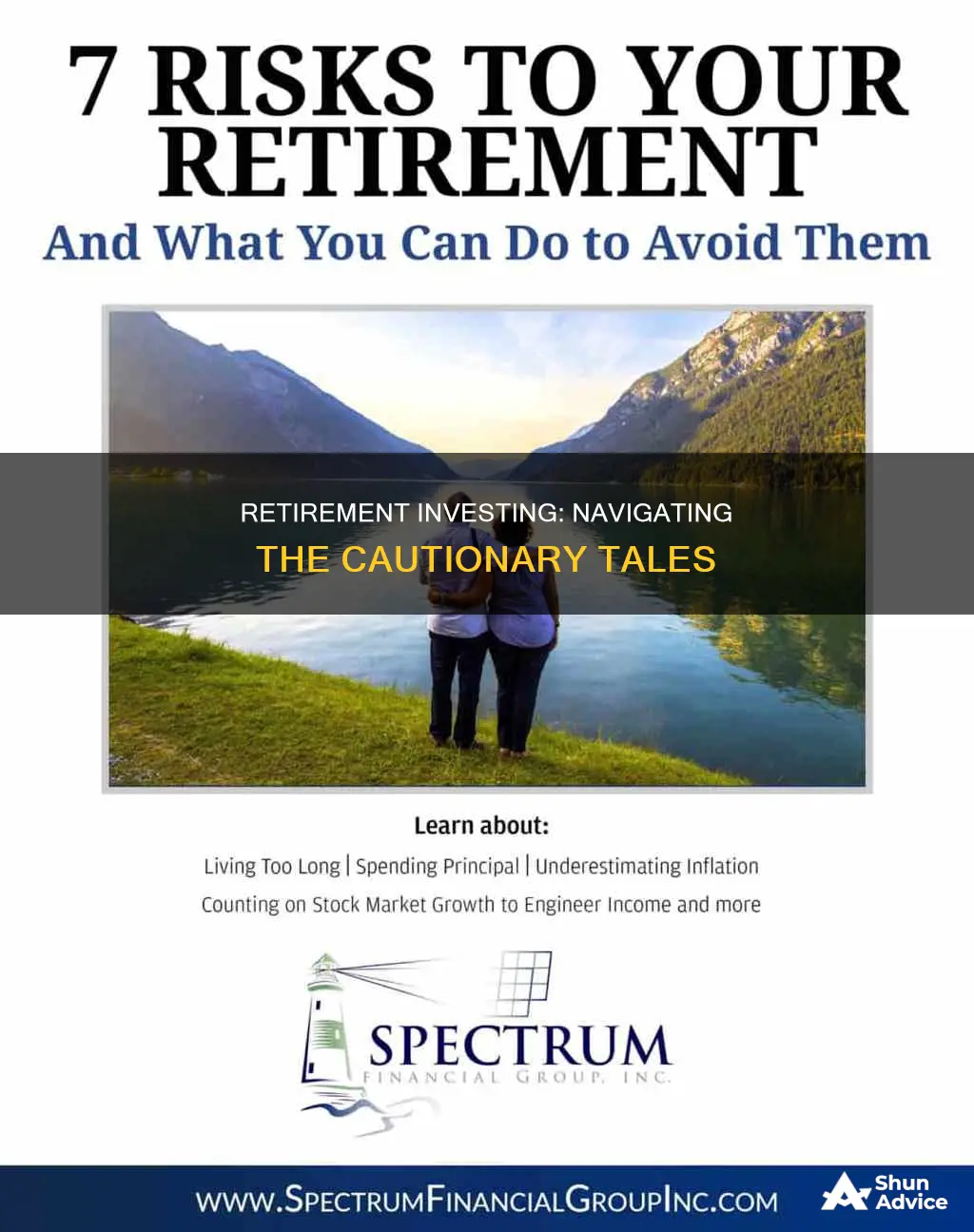
When it comes to investing for retirement, there are several things to be cautious about. Firstly, it is important to start saving and investing as early as possible to take advantage of compound interest and give your investments time to grow. This also allows for a longer period to recover from any losses. It is also crucial to understand your risk tolerance and choose investments accordingly. While taking on more risk can lead to greater gains, it can also result in significant losses. Therefore, assessing your financial circumstances and retirement goals is essential. Additionally, it is important to be cautious when withdrawing from retirement savings. Withdrawing too much too soon can lead to exhausting your portfolio before the end of your retirement. Finally, it is beneficial to seek advice from a financial professional to help navigate the complexities of retirement planning and investing.
| Characteristics | Values |
|---|---|
| Fees | Can significantly erode your retirement funds |
| Emotions | Can influence your investments |
| Risk tolerance | Depends on your financial circumstances and goals |
| Investment types | Stocks, bonds, annuities, mutual funds, exchange-traded funds, etc. |
| Savings accounts | Local bank, employer-based retirement plan, IRA, 401(k), etc. |
| Retirement age | Affects your investment risk tolerance and timeline |
| Income sources | Current and projected income impact your retirement savings |
| Expenses | Affect your retirement savings and spending plan |
| Health history | Determines health coverage needs in retirement |
What You'll Learn

Understand your retirement account options
Understanding your retirement account options is a crucial aspect of retirement planning. Here are some detailed insights to help you navigate the various options available:
Tax-Advantaged Accounts
These include 401(k) plans and Individual Retirement Accounts (IRAs), which offer tax-deferment benefits. With these accounts, you don't pay taxes on contributions or earnings until you make withdrawals during retirement. Traditional 401(k)s and IRAs are funded with pre-tax dollars, providing tax deductions for contributions. On the other hand, Roth 401(k)s and Roth IRAs are funded with after-tax dollars, offering tax-free withdrawals but no tax deductions on contributions.
Taxable Accounts
These accounts, often held at brokerage firms or banks, are funded with after-tax dollars. Examples include brokerage accounts and some types of retirement accounts like annuities. While these accounts don't offer upfront tax breaks, they can still be valuable components of your overall retirement strategy.
Defined-Benefit Plans (Pensions)
These are employer-funded retirement plans that guarantee a specific benefit based on factors like salary history and duration of employment. However, they are becoming less common outside of the public sector.
K)s and Company Plans
These are employer-sponsored defined-contribution plans funded by employees. They offer tax incentives, automatic savings, and sometimes matching contributions from employers. Contribution limits for these plans are set by the IRS and are subject to change annually.
IRAs (Individual Retirement Accounts)
IRAs provide tax-deferred investing benefits. With traditional IRAs, you can deduct contributions if you meet certain requirements, and withdrawals are taxed at retirement. Roth IRAs, on the other hand, don't allow tax deductions on contributions but offer tax-free withdrawals. IRAs typically have lower contribution limits compared to 401(k)s and also have catch-up contribution options for individuals aged 50 or older.
SEP IRAs (Simplified Employee Pension)
These are established by employers or the self-employed and allow tax-deductible contributions on behalf of eligible employees. The annual contribution is limited and depends on the employee's compensation or a specified maximum amount.
SIMPLE IRAs (Savings Incentive Match Plan for Employees)
These retirement plans are designed for small businesses with 100 or fewer employees. They offer employees a simplified way to contribute to their retirement savings, with higher contribution limits compared to traditional or Roth IRAs.
Types of Investments
When considering retirement account options, it's important to understand the types of investments available. Here are a few common options:
- Annuities: Insurance products that provide a regular income stream during retirement.
- Mutual Funds: Professionally managed pools of stocks, bonds, and other instruments that are sold to investors as shares.
- Stocks: Securities representing ownership in a corporation.
- Bonds: Securities representing money loaned to an issuer (government or corporation) in exchange for interest payments and repayment of the face value.
- Exchange-Traded Funds (ETFs): Investment funds that trade on regulated exchanges, tracking indexes, commodities, or baskets of assets.
- Cash Equivalents: Low-risk, short-term investments like certificates of deposit (CDs) and money market deposit accounts.
- Dividend Reinvestment Plans (DRIPs): Plans that allow reinvestment of cash dividends to purchase additional shares, helping build wealth through compound interest.
Remember, understanding your retirement account options is a crucial step in securing your financial future. It's always a good idea to consult with a financial professional to help you navigate the complexities of retirement planning and choose the options that align with your goals and risk tolerance.
Smart Ways to Invest $2,500 Today
You may want to see also

Calculate your net worth
Calculating your net worth is a great way to understand your financial health. Net worth is the value of all your assets minus the total of all your liabilities. In other words, it is what you own minus what you owe. A positive net worth is a good sign, indicating that your assets exceed your liabilities. Conversely, a negative net worth means your liabilities exceed your assets, and it's time to focus on debt reduction.
Here's a step-by-step guide to calculating your net worth:
- Identify your assets: These are valuable possessions that you own. They can be further categorised into liquid assets and fixed assets. Liquid assets include cash, such as money in your bank accounts, retirement accounts, and investments that can be quickly converted to cash, like stocks and bonds. Fixed assets are items you own that are less liquid, such as your car or house. Even if you are still paying off your car or mortgage, the portion you own is considered an asset.
- Determine your liabilities: These are your financial debts and obligations. They include credit card debt, student loans, mortgages, auto loans, and any other money you owe. If you are including fixed assets like your home, then the mortgage on that property should also be considered a liability.
- Do the math: Subtract the total value of your liabilities from the total value of your assets. The resulting figure is your net worth.
For example, let's say you have $100,000 in a retirement account, $2,000 in savings, $1,500 in a checking account, and a home worth $250,000. Your total assets would be $353,500. Now, if you owe $5,000 in credit card bills, $20,000 for a car loan, $5,000 in student loans, and $150,000 on your mortgage, your total liabilities are $180,000. Subtracting your liabilities from your assets, your net worth would be $173,500.
It's important to note that your income is not included in the net worth calculation. Net worth is a snapshot of your financial position at a given moment, and it can change over time as your assets and liabilities fluctuate.
Young Investors: Where to Begin?
You may want to see also

Keep your emotions in check
Emotions and retirement investments shouldn't mix. While it is normal to feel emotional about investing, letting these emotions drive your decisions can lead to poor outcomes. Fear, greed, envy, and overconfidence can cause investors to sell at a loss or buy at a high, sabotaging potential gains.
- Automate your investments: By automating investments through regular contributions to retirement plans or setting up automatic withdrawals, you remove emotions from the equation. This approach, known as dollar-cost averaging, has proven successful over time, allowing you to avoid emotional responses to market events.
- Avoid financial media during crises: Tuning into financial media during a crisis can expose you to emotional commentary from market experts, triggering your own emotional responses. Instead, stick to your investment plan and ignore the news until the situation improves.
- Understand your "why": Remind yourself of your investment goals and objectives during times of market stress. Knowing why you are investing can help you stay calm and focused.
- Avoid market timing: Emotional reactions to a deteriorating economy, such as selling all your stocks to avoid losses, can be detrimental. Instead, consider various scenarios and position your portfolio based on the most likely outcomes.
- Hire a financial advisor: If you struggle to manage your emotions, consider hiring a financial advisor. They can provide valuable advice and help you make well-reasoned decisions.
- Be realistic: Not every investment will be a winner, and it's important to accept that. Be mindful of your wins and losses and take the time to evaluate your choices and learn from them.
- Maintain a balanced portfolio: Diversify your investments based on your age, risk tolerance, and goals. Older adults, for example, typically shift towards lower-risk investments, while younger investors can focus on higher-risk/higher-reward options.
- Consult with experts: Consulting a financial expert can help you evaluate your thinking and give you time to make more rational decisions.
By following these strategies, you can make more logical and emotionally detached investment decisions, increasing your chances of achieving your long-term retirement goals.
Japanese Retirement Strategies: Navigating Stagflation
You may want to see also

Pay attention to fees
When investing for retirement, it is crucial to pay attention to the fees involved, as they can significantly impact your investment performance and returns over time. Here are some essential things to keep in mind regarding investment fees:
Understand the Types of Fees
Investment fees can be structured in different ways, and it's important to know what you're paying for:
- Ongoing fees—These are recurring charges that you incur on a regular basis, such as quarterly or annual account maintenance fees. They are typically calculated as a percentage of the funds in your account.
- Trading/Transaction fees—These are one-time charges that occur each time you buy, sell, or exchange shares or ETFs. These fees can vary depending on the platform and services used by your broker and can range from less than $5 to more than $20 per transaction.
- Loads/Sales Commissions—When you invest in a mutual fund, you may be charged a load or sales commission. There are front-end loads, which are paid when you invest, and back-end loads, which are charged when you withdraw money. No-load funds don't have these commissions but may have higher maintenance fees.
- Management fees—These fees are paid to the fund manager or team of investing professionals who ensure the fund performs well and achieve its objectives.
- Distribution and service fees—These cover the fund's marketing and selling costs.
- Administrative fees—These include fees for salaries, record-keeping, and research.
Compare Expense Ratios
The expense ratio of a mutual fund is a percentage of its investment account balance and covers various fees and expenses. When comparing mutual funds, look at their expense ratios to understand the overall cost of investing in each fund. Remember that a high expense ratio doesn't always indicate better performance or higher returns.
Be Mindful of Embedded Fees
Some fees are embedded and not always visible day-to-day. For example, on a $10,000 portfolio, you might be paying $200 to $250 per year in fees without realizing it. As your portfolio grows, these fees can increase significantly. Be sure to review your statements and ask questions to understand all the fees you're paying.
Evaluate the Impact of Fees on Returns
Fees directly impact your investment returns. For example, if you assume a 5% net return, you may need to achieve a 7% return if you have a 2% annual fee, meaning 28.6% of your return goes towards fees. As the return decreases, the impact of fees becomes more significant. Over time, even a small difference in fees can result in a substantial difference in your overall returns.
Consider Lower-Fee Alternatives
If you find that you're paying high fees, shop around for lower-fee alternatives. You may be able to find comparable mutual funds with lower expense ratios or brokers that offer reduced transaction costs. By lowering your fees, you can increase the probability of higher returns.
Aussie-Made Knives: Cutting-Edge Quality and Craftsmanship
You may want to see also

Understand your risk tolerance
Understanding your risk tolerance is a crucial aspect of retirement planning. It involves assessing how much risk you are willing to take on in your investments, given your financial goals, time horizon, and personal circumstances. Here are some key considerations to help you understand your risk tolerance:
Investment Goals and Time Horizon
The first step in understanding your risk tolerance is to define your investment goals. Are you saving for retirement, a child's education, or another financial milestone? The time horizon for your investments will impact your risk tolerance. If you have a long-term investment goal, such as retirement, you may have more flexibility to take on higher-risk investments. Conversely, if you are saving for a short-term goal, you may prefer lower-risk options to protect your capital.
Age and Life Stage
Age is often a factor in determining risk tolerance. Generally, younger investors are considered to have a higher risk tolerance since they have a longer time horizon for their investments to recover from potential losses. However, it's important to remember that age is not the sole determinant, and individuals should not automatically shift from stocks to lower-risk assets as they reach retirement age. With advancements in medical science and increasing life expectancies, retirees may still have a long investment horizon and can remain aggressive investors.
Net Worth and Risk Capital
Your net worth and available risk capital play a significant role in your risk tolerance. Investors with a higher net worth and more liquid capital can afford to take on more risk, as they have a larger buffer to withstand potential losses. Conversely, those with limited net worth or risk capital may need to be more cautious to avoid taking on excessive risk.
Investment Experience and Knowledge
Your level of investment experience and knowledge will influence your risk tolerance. If you are new to investing, it's prudent to start with a degree of caution and gradually increase your risk exposure as you gain experience and confidence. More experienced investors may be comfortable taking on higher-risk investments, especially if they have a track record of successful investing.
Emotional Tolerance
Another aspect of risk tolerance is emotional tolerance, which refers to how comfortable you are with market volatility and potential losses. Some investors may become anxious or stressed when their investments fluctuate in value. Understanding your emotional tolerance will help you determine the level of risk that aligns with your comfort level.
Risk Tolerance Assessments
To gain a clearer understanding of your risk tolerance, you can utilise online risk tolerance assessments, surveys, or questionnaires. These tools can provide valuable insights into your risk appetite and help guide your investment decisions. Additionally, reviewing historical returns for different asset classes can give you a sense of the volatility associated with various investment options.
In conclusion, understanding your risk tolerance is essential for making informed investment decisions during retirement planning. By considering factors such as your investment goals, age, net worth, experience, and emotional tolerance, you can design a portfolio that aligns with your risk tolerance and helps you achieve your financial objectives.
Smart Ways to Invest $20,000
You may want to see also
Frequently asked questions
When assessing your risk tolerance, it's important to be practical and consider your financial circumstances. Ask yourself the following:
- Do you anticipate your income growing considerably or only moderately in the coming years?
- Do you have worries about the stock market?
- What type of lifestyle do you want, and how does this align with your retirement goals?
- At what age do you hope to retire, and what does your ideal retirement look like?
Some low-risk investment options for retirees include:
- Money market funds
- High-dividend blue-chip stocks
- Bank certificates of deposit (CDs)
- Fixed index annuities
- Bond funds
- High-yield savings accounts
- A 60/40 mix of stocks and bonds
It's important to be cautious and consider the long-term when withdrawing from retirement savings. Withdrawing too much too soon can lead to portfolios failing to last through retirement. A general rule of thumb is to withdraw no more than 4-5% of your portfolio annually to ensure it lasts at least 30 years.







